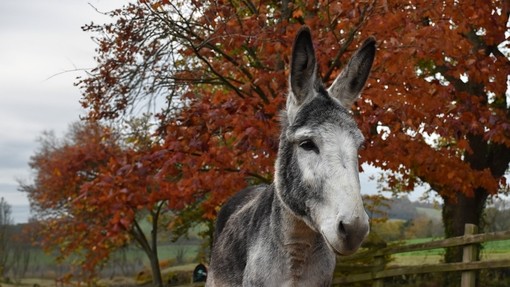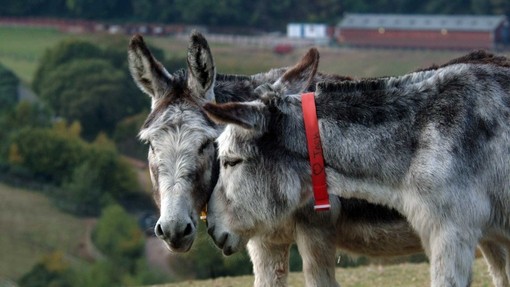
Winter veg and fruit for your donkeys
With the last of the summer fruit and vegetables picked and preserved, the colder months clear the way for hardier UK crops that can brave the chill. A wide range of healthy fruit and veg can thrive in the colder climate, making it a rich harvesting period for the green-fingered gardener. The best part is that this fresh produce can also provide enrichment to donkeys – but not all of it is good for our four-hooved friends. Sarah Worth, a donkey nutrition expert at The Donkey Sanctuary, reveals which winter fruit and veg is safe for donkeys, and which you should avoid.

Sarah says: “Carrots are a great choice as an occasional winter snack for donkeys. They contain 80 percent water, making them a succulent source of hydration, particularly when there is limited access to grazing or if their diet is dry during the winter months.
“The best way to give donkeys carrots is by slicing them lengthways or grating them and sprinkling them into the straw. This makes feeding time more fun!
“Parsnips are also a good alternative to carrots, though you may find some donkeys aren’t keen on the taste. I would also advise against feeding donkey wild parsnip as it can cause reactions to their skin similar to sunburn.”

Sarah says: “White turnips and swedes are perfectly fine for donkeys in moderation – providing a refreshing, crunchy treat. It is a popular practice to hang swedes or turnips safely in a donkey’s stable. This provides a dexterous challenge for donkeys, although it can be frustrating if the suspended swede is too difficult to chomp on or detach from the twine.
“Make sure you’re present if you hang the swede up so you can safely dispose of the twine or string once the vegetable has been plucked.”

Sarah says: “While donkeys might enjoy the above vegetables, be aware that some veggies are best avoided. Our no-grow list includes broccoli, Brussels sprouts, cabbage, cauliflower, collard greens, kale, potatoes and onions.”

Apples
Sarah says: “Apples are a wonderful, sweet treat for donkeys but should always be offered in moderation. They are best prepared halved or quartered. There is a temptation to feed donkeys a lot of apples if you have a bumper harvest. However, too many apples can increase the risk of developing digestive upset.”
Are pumpkins a perfect pick?
Although the spooky season is now behind us, many households’ doorsteps would have been adorned with pumpkins just a few months ago. We often get asked in autumn if pumpkins are safe for donkey consumption – the answer is yes, but we recommend only giving them orange varieties as an autumnal treat.

However, there are still several factors that need to be considered.
Make sure the pumpkin is fresh and shows no sign of mould or rot. You will also need to ensure there is no candle wax residue, paint or inedible decorations on the pumpkin if it had previously been used in Halloween celebrations. Orange varieties of pumpkin are also best served in small manageable slices. This will reduce the risk of choking and avoid digestive upset.
Make your winter veg go further
Here’s a great way to utilise your winter veg differently - by integrating it into a wonderfully festive willow wreath! Follow this easy step-by-step guide by Equine Assistant Stephy Studley to add a tasty enrichment activity to your donkey’s paddock this Christmas.

Step 1: To build your enrichment willow wreath, gather your supplies. You’ll need freshly-harvested willow or hazel, a selection of winter veg cut into batons, fresh herbs such as rosemary, thyme and mint, and a pair of secateurs. For this demonstration, we’ll be using willow.

Step 2: Bend a strip of willow to form a circle and tie it in a loose knot. Weave in any excess to make the wreath more secure.

Step 3: Weave in more pieces of willow around your circle to build up the frame. Leave enough space between each willow branch so you can poke in your herbs.

Step 4: Continue building up the wreath until you have created a sturdy frame. Include more or less willow branches depending on whether you want a chunky or slimmer wreath.

Step 5: Start threading in the rosemary, thyme and mint. Firmly embed the herbs in the wreath to encourage your donkey’s natural foraging behaviours. They will enjoy snuffling out the herbs and pulling at them with their teeth.

Step 6: Continue adding to your wreath. This is an opportunity to get creative and add in any non-herbal flora your donkey is particularly partial to. This can also include thistles and gorse. If you’re not sure what greenery is donkey-safe, check out our resource about safe trees and shrubs for donkeys.

Step 7: Add the vegetable batons to your enrichment wreath. Make sure the vegetables are cut into safe-sized batons and not fed to your donkey whole as this could cause a choking hazard.

Step 8: Continue adding the vegetables batons ensuring they are evenly spread out around the whole of your enrichment wreath. Your wreath should now be complete and look full of tasty treats for your donkey.

Step 9: Once your wreath is complete, you can use another willow branch to tie your wreath to a fence post or let it hang in the donkey’s stable. As willow is safe for donkeys to eat, it’s a much safer option than using twine or string.

Step 10: Enjoy seeing your donkey’s natural foraging behaviours shine! Your newly made enrichment wreath is a wonderful way to stimulate their senses during the colder months.
Share this page
Tags
- Blog












